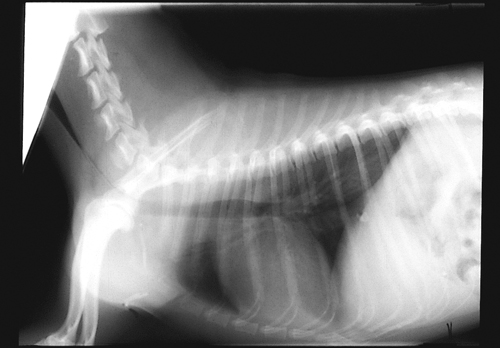Small Animal Emergency and Critical Care Medicine Q&A 05
| This question was provided by Manson Publishing as part of the OVAL Project. See more Small Animal Emergency and Critical Care Medicine Q&A. |
A six-year-old, castrated male Yorkshire Terrier is presented with a 2-year history of coughing. Today the dog is coughing almost constantly. He has cyanotic mucous membranes and markedly increased inspiratory effort. Radiographs had been taken at a previous visit.
| Question | Answer | Article | |
| What is the diagnosis? | Collapsing trachea. |
Link to Article | |
| If radiographs had not confirmed the diagnosis, what additional tests could be performed to diagnose this condition? | Radiographs should be taken at full inspiration and full expiration to maximize the possibility that the collapse will be evident on the film. Fluoroscopy, if available, may be more successful at demonstrating an intermittent collapse. Bronchoscopy may allow direct visualization of the collapsing segment, although the trachea may not collapse as dramatically when the dog is under anesthesia. It may be possible to identify weakened tracheal rings and dorsoventral flattening by simple palpation of the cervical region. |
Link to Article | |
| What therapeutic procedures should be instituted immediately? | Oxygen supplementation. Consider sedation (acepromazine – 0.05 mg/kg i/v or s/c), corticosteroids (prednisolone sodium succinate [2–4 mg/kg i/v] or dexamethasone sodium phosphate [0.2–2.2 mg/kg i/v]) and bronchodilators (aminophylline – 11 mg/kg slow i/v). |
Link to Article | |
| What medical and surgical options exist for long-term management of this condition? | Medical management involves the use of bronchodilators (aminophylline or theophylline [10 mg/kg p/o tid] or terbutaline [1.25–5.0 mg/dog p/o bid–tid]), cough suppressants (butorphanol [0.5 mg/kg p/o bid–qid], hydrocodone [0.25 mg/kg p/o bid–tid], dextromethorphan [2.2 mg/kg p/o bid–tid]) and anti-inflammatory agents (prednisone – 0.25–0.5 mg/kg p/o bid). A search for a bacterial component of bronchitis is warranted. There are several surgical options. These include plication of the dorsal tracheal membrane, tracheal ring resection, placement of internal stents or external prosthetic rings, or spiral prosthesis. Careful examination for laryngeal paralysis is indicated before surgical correction. |
Link to Article | |
